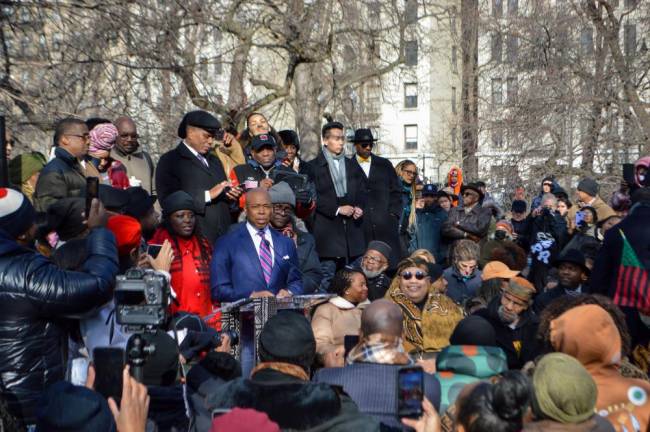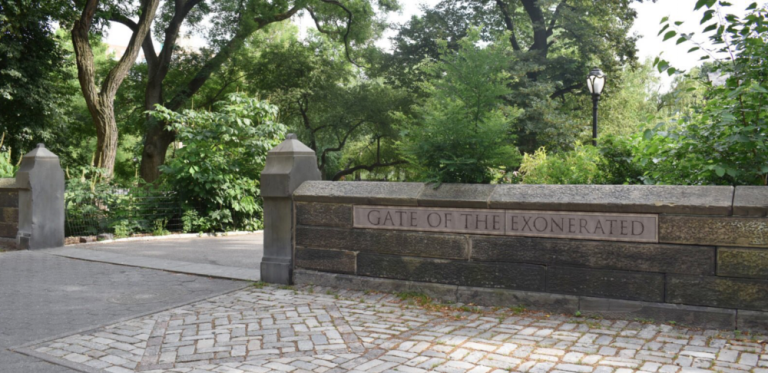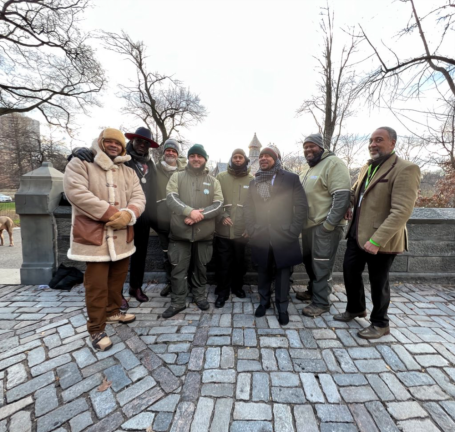‘Gate Of The Exonerated’ Honors Central Park’s ‘Exonerated Five’
The gate naming ceremony on Monday, Dec. 19 was the first in 160 years, attended by politicians, religious leaders and three of the five New Yorkers wrongly convicted of a 1989 crime



Central Park’s entrances bear names intended to represent the people of New York: Scholars’ Gate, Artists’ Gate, Engineers’ Gate, Merchants’ Gate and more. On Monday, Dec. 19, a new category was added to the list — for the first time in 160 years.
“Although what brought us together for this cause is the product of hatred and injustice, we hope that this, the ‘Gate of the Exonerated,’ can live on as a positive message of change, of healing and freedom,” said Parks Commissioner Sue Donoghue. A large crowd gathered that morning for what she called a “bittersweet occasion,” cheering, clapping and singing in the cold.
The gate naming ceremony at the park entrance on 110th Street between Fifth Avenue and Malcolm X Boulevard brought together politicians, religious leaders and three of the “Exonerated Five,” formerly known as the “Central Park Five,” Yusef Salaam, Kevin Richardson and Raymond Santana. “The ‘Exonerated Five’ is the American Black boy — man — story,” Mayor Eric Adams said.
In 1989, Salaam, Richardson and Santana, along with Antron McCray and Korey Wise, were arrested in connection with the rape of a white female jogger in Central Park. They served prison sentences before their convictions were overturned in 2002, after DNA evidence surfaced along with a confession from the real perpetrator and convicted murderer, Matias Reyes. The five were eventually awarded $41 million by the city in 2014 in compensation for the wrongful convictions.
“The truth is, we shouldn’t be here today,” said Alvin Bragg, Manhattan’s 37th District Attorney. “We’re here today because of mistakes made by my office.”
Freedom At Last
In 2019, “an idea to highlight social justice and the ‘Exonerated Five’ was born” in Community Board 10, the board’s current chair, Cicely Harris, said on Monday. Community board members collaborated with the Parks Department and the Central Park Conservancy; Council Member Gale Brewer, then the Manhattan Borough President, set in motion a campaign that eventually resulted in unanimous borough-wide support.
“They were criticized, they were attacked,” Borough President Mark Levine said of those involved in the dedication of the Central Park gate. “They were told that this was an inappropriate action and they stood strong.”
Now, an exhibit on the history of Central Park’s gates is also on display in the Charles A. Dana Discovery Center, steps from the new “Gate of the Exonerated.” “We’re reshaping the image of Central Park so that it reflects truthfully the history of the park and its people,” Brewer said.
Santana said he hadn’t visited the park since his exoneration. On Monday, his daughter joined him.
Other speakers highlighted the fortitude of the “Exonerated Five” and their families, who fought against their wrongful convictions. “A whole city — nation — was against children, five little boys at the time,” said NYS Senator Cordell Cleare. “The convictions were overturned, under pressure...and we were that pressure.”
The Fight Continues
Many continue to be accused of and incarcerated for crimes they did not commit, speakers emphasized. “Let us not act like this is something that is not also continuing to happen today,” Reverend Al Sharpton said. “Because the ‘Exonerated Five’ is symbolic of many that need to still be exonerated.” He referenced a 2020 incident in the park when a Black birder, Christian Cooper, was falsely accused by a white dog walker of threatening her.
Sharpton and others also acknowledged that on the same morning as the gate dedication, the House’s Jan. 6 committee recommended that criminal charges be brought against former President Donald Trump, in relation to last year’s attack on the Capitol. In 1989, Trump bought advertisements in multiple New York City newspapers calling for the death penalty in certain criminal contexts, in light of the Central Park assault.
A Path Forward
The gate, though specifically named for the “Exonerated Five,” is intended to represent a larger swath of New Yorkers. “This community, when they see it, I hope they feel uplifted in knowing that there is a way out of hell if you just hold on,” said Sharonne Salaam, Yusef Salaam’s mother.
It now serves as a physical representation of years of work. “This is not over everybody,” Richardson said. “This is just a spark, this is just a lighting of the torch.”
“The ‘Exonerated Five’ is the American Black boy — man — story.” Mayor Eric Adams